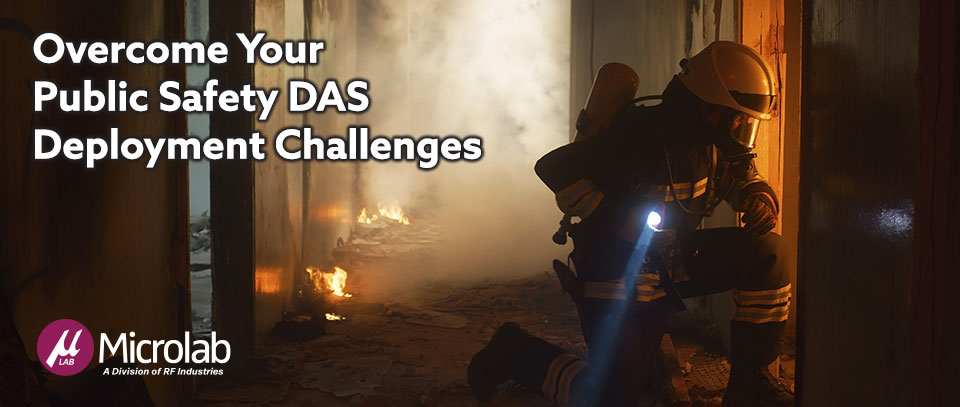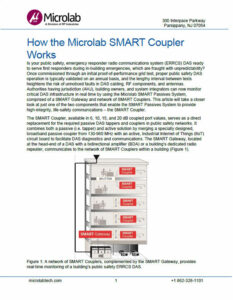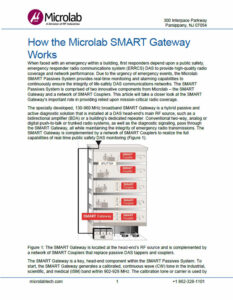Microlab is a leading component and integrated solution partner relied on for tackling the challenges with public safety distributed antenna system (DAS) and wide-area, land mobile radio (LMR) dispatch network deployments. RF engineers and technicians who design and deploy these systems and are looking to increase confidence in DAS designs, reduce deployment costs, maintain deployment schedules, and minimize DAS downtime turn to Microlab for their solutions.

READ MORE
An Emergency Responder Radio Communications System (ERRCS), also known as a Public Safety or First Responder DAS (Distributed Antenna System), has been mandated by many Authorities Having Jurisdiction (AHJ) for new buildings around the country.
The municipal jurisdiction’s code requirements are defined by the International Code Council (ICC) and the National Fire Protection Association (NFPA). IFC Section-510 and NFPA 1221 provides the public safety DAS system requirements.
Various AHJ’s are recommending that all passive DAS networks be equipped with a remote monitoring system that detects faults in the passive network of RF coaxial cables, components, and antennas deep into a building. Historically, only the active components (BDA’s and power supplies) were monitored.
Without real-time passive DAS monitoring and alarming, a Public Safety DAS may not be ready for life safety radio traffic. When the Public Safety DAS is commissioned an acceptance grid test is conducted. If the public safety DAS RF coverage passes in a brand-new building, a certificate of occupancy or CO will be granted by the AHJ. From the date of commissioning, it is typical for the AHJ to conduct annual testing of the DAS. Therein lies the problem for first responders that rely on the Public Safety DAS during emergency incidents. It can be a year or more between a system’s proof of performance testing.
The probability of damage to RF coaxial transmission lines or components, disconnected antennas, and the like are high over the course of a year. This is due to building maintenance and enhancements including, plumbing, HVAC repair, security systems, and computer network cabling work. Something as simple as disconnecting an antenna and forgetting to re-connect it to DAS transmission line will compromise DAS integrity and impede proper radio performance.

+ Increase Confidence in DAS Designs
- Experienced application support can offer consultation to optimize system designs
- Custom designs available for combining multiband / multi-jurisdiction networks
- Guaranteed (vs. typical) specifications ensure expected behavior and reduce need for redesign
- Higher MTBF components enable more reliable systems
- Components supported by Ranplan and/or iBwave design tools
- Read the Article Increase Confidence in DAS Designs
+ Reduce Deployment Costs
- More accurate designs better ensure proper operation and reduces system re-work in the field
- Higher performance components enable fewer components to achieve the same coverage
- Wide bandwidth products can be utilized to future proof system deployments
- Broad portfolio simplifies logistics and provides opportunities for volume discounts
- Experienced application support can offer suggestions for more cost-effective system architectures
- Guaranteed (vs. typical) specifications ensure expected behavior and reduce need for redesign
- Read the Article Reduce Deployment Costs
+ Maintain Deployment Schedules
- Most popular products in stock
- Large distribution network for additional product availability options
- Recommendations available for alternate components with shorter lead times
- Read the Article
+ Minimize DAS Downtime
- SMART components detect system performance deterioration before catastrophic failure
- Higher MTBF components enable more reliable systems
- US-based company with in-country support enables timely customer support
- Experienced application engineers available to help with troubleshooting if needed
- Read the Article Minimize DAS Downtime
SMART Passives System
SMART (System Monitor Alarm Report Technology) Passives enables real-time performance monitoring of a Public Safety DAS structured cabling, RF components, and antennas deep into a building. The SMART System is made up of a SMART Gateway and SMART Couplers. The SMART Coupler was designed to replace common passive DAS tapper or coupler values. A building’s DAS network of SMART Coupler nodes is complemented by a SMART Gateway at the head-end’s main RF source.
Public safety DAS and wide-area LMR dispatch network products are available in all the following categories
Custom versions of many components are available. Click for more information.






